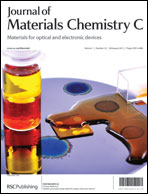The properties of functional ceramics and their performance in industrial applications are strongly affected by the processing treatments. We report on long term stability of aqueous 0.5Ba(Zr0.2Ti0.8)O3–0.5(Ba0.7Ca0.3)TiO3 (BZT–BCT) suspensions. The effects of aging time on pH and on the leaching extents of Ba, Zr and Ca elements were systematically investigated for the naked, and the surface treated particles against hydrolysis. Suspensions with solid loadings (Φ) up to 60 vol%, pseudoplastic flow behaviours and long term colloidal stability could be achieved from the surface treated powder. A fractal dimension (D) of ∼1.97 to 1.98 was estimated for the BZT–BCT suspensions from the yield stress (τy) versus (Φ) dependence, suggesting a reaction limited cluster aggregation (RLCA) type of particle aggregation with a substantial rearrangement occurring in the aggregates under shearing. The maximum solid loading (Φm) ≈ 61 vol% was determined. The concentrated and stable suspensions represent a stride for successful processing of functional BZT–BCT ceramic components via various aqueous colloidal shaping methods (slip casting, gel-casting, etc.) for large scale industrial applications.

You have access to this article
 Please wait while we load your content...
Something went wrong. Try again?
Please wait while we load your content...
Something went wrong. Try again?


 Please wait while we load your content...
Please wait while we load your content...